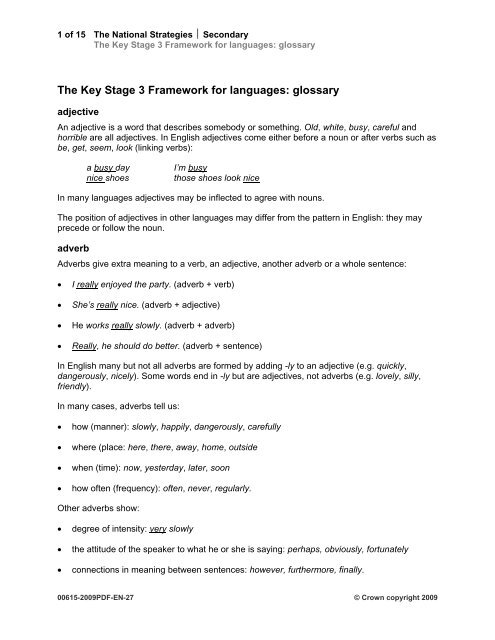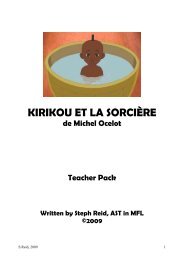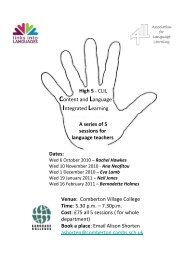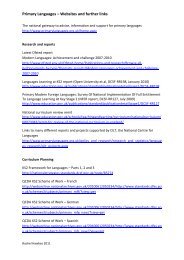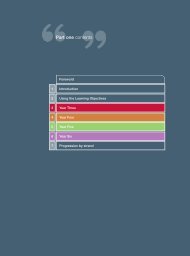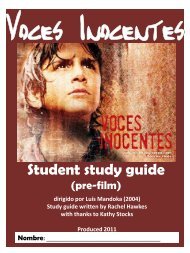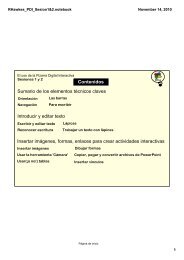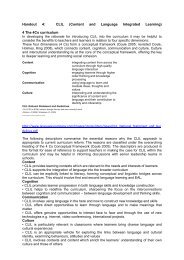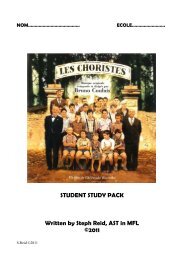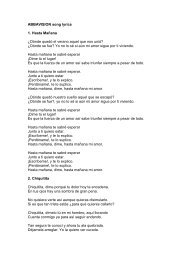Key Stage 3 Framework for languages ... - Rachel Hawkes
Key Stage 3 Framework for languages ... - Rachel Hawkes
Key Stage 3 Framework for languages ... - Rachel Hawkes
Create successful ePaper yourself
Turn your PDF publications into a flip-book with our unique Google optimized e-Paper software.
1 of 15 The National Strategies ⏐ Secondary<br />
The <strong>Key</strong> <strong>Stage</strong> 3 <strong>Framework</strong> <strong>for</strong> <strong>languages</strong>: glossary<br />
The <strong>Key</strong> <strong>Stage</strong> 3 <strong>Framework</strong> <strong>for</strong> <strong>languages</strong>: glossary<br />
adjective<br />
An adjective is a word that describes somebody or something. Old, white, busy, careful and<br />
horrible are all adjectives. In English adjectives come either be<strong>for</strong>e a noun or after verbs such as<br />
be, get, seem, look (linking verbs):<br />
a busy day<br />
nice shoes<br />
I’m busy<br />
those shoes look nice<br />
In many <strong>languages</strong> adjectives may be inflected to agree with nouns.<br />
The position of adjectives in other <strong>languages</strong> may differ from the pattern in English: they may<br />
precede or follow the noun.<br />
adverb<br />
Adverbs give extra meaning to a verb, an adjective, another adverb or a whole sentence:<br />
• I really enjoyed the party. (adverb + verb)<br />
• She’s really nice. (adverb + adjective)<br />
• He works really slowly. (adverb + adverb)<br />
• Really, he should do better. (adverb + sentence)<br />
In English many but not all adverbs are <strong>for</strong>med by adding -ly to an adjective (e.g. quickly,<br />
dangerously, nicely). Some words end in -ly but are adjectives, not adverbs (e.g. lovely, silly,<br />
friendly).<br />
In many cases, adverbs tell us:<br />
• how (manner): slowly, happily, dangerously, carefully<br />
• where (place: here, there, away, home, outside<br />
• when (time): now, yesterday, later, soon<br />
• how often (frequency): often, never, regularly.<br />
Other adverbs show:<br />
• degree of intensity: very slowly<br />
• the attitude of the speaker to what he or she is saying: perhaps, obviously, <strong>for</strong>tunately<br />
• connections in meaning between sentences: however, furthermore, finally.<br />
00615-2009PDF-EN-27 © Crown copyright 2009
2 of 15 The National Strategies ⏐ Secondary<br />
The <strong>Key</strong> <strong>Stage</strong> 3 <strong>Framework</strong> <strong>for</strong> <strong>languages</strong>: glossary<br />
analogy<br />
An analogy can consist of:<br />
• a perception of similarity between two things<br />
• a comparison made to show such a similarity<br />
• relating something known to something new (e.g. using knowledge of familiar words and<br />
sound patterns to work out how to pronounce new words).<br />
article<br />
A, an and the are articles. In English, a (an be<strong>for</strong>e a vowel sound) is the indefinite article; the is<br />
the definite article. In other <strong>languages</strong>:<br />
• there may be more or fewer articles than in English<br />
• articles are sometimes used where English does not use an article<br />
• articles may agree with the nouns they refer to.<br />
clause<br />
A clause is a group of words that expresses an event (she drank some water) or a situation (she<br />
was thirsty/she wanted a drink). It usually contains a subject (she in the examples) and verb<br />
(drank/was/wanted).<br />
A clause differs from a phrase (see definition of 'phrase').<br />
A sentence is made up of one or more clauses:<br />
It was raining. (one clause)<br />
It was raining and we were cold. (two main clauses joined by and)<br />
It was raining when we went out. (main clause containing a subordinate clause – underlined)<br />
A main clause is complete on its own and can <strong>for</strong>m a complete sentence (e.g. It was raining.). A<br />
subordinate clause (when we went out) is part of the main clause and cannot exist on its own. In<br />
the following examples, the subordinate clauses are underlined.<br />
You’ll hurt yourself if you’re not careful.<br />
Although it was cold, the weather was pleasant enough.<br />
Where are the biscuits (that) I bought this morning<br />
John, who was very angry, began shouting.<br />
What you said was not true.<br />
Although most clauses require a subject and verb, some subordinate clauses do not. In many<br />
such cases, the verb be can be understood. For example:<br />
The weather, although rather cold, was pleasant enough. (= although it was rather cold)<br />
00615-2009PDF-EN-27 © Crown copyright 2009
3 of 15 The National Strategies ⏐ Secondary<br />
The <strong>Key</strong> <strong>Stage</strong> 3 <strong>Framework</strong> <strong>for</strong> <strong>languages</strong>: glossary<br />
When in Rome, do as the Romans do. (= when you are in Rome)<br />
Clause use in other <strong>languages</strong> may involve issues of word order and punctuation.<br />
cognate<br />
Technically means 'from the same root or origin'. In <strong>languages</strong>, the term is commonly used to<br />
denote words which are identical with or very close to their English equivalent in spelling and<br />
meaning, <strong>for</strong> example important in English and French; house and Haus in English and German.<br />
Words may be technically cognates but their use or meaning may have diverged from English<br />
over time (e.g. English and German so).<br />
compound sentence<br />
A compound sentence is made up of more than one clause. For example:<br />
I hate pasta. (simple sentence)<br />
I love chips. (simple sentence)<br />
I hate pasta but I love chips. (compound sentence, using the conjunction but to join the two<br />
sentences together)<br />
compound word<br />
A word made up of two other words, <strong>for</strong> example football, headrest, broomstick.<br />
Compound words in other <strong>languages</strong> may be <strong>for</strong>med with hyphens (as in French) or based on<br />
some variant of the English pattern (as in German).<br />
conjunction<br />
A word used to link clauses within a sentence. For example, in the following sentences but and if<br />
are conjunctions.<br />
It was raining but it wasn’t cold.<br />
We won’t go out if the weather’s bad.<br />
There are two kinds of conjunctions:<br />
• coordinating conjunctions (and, but, or and so), which join two clauses of equal weight –<br />
Do you want to go now or shall we wait a bit longer<br />
And, but and or are also used to join words or phrases within a clause.<br />
• subordinating conjunctions (e.g. when, while, be<strong>for</strong>e, after, since, until, if, because, although,<br />
that), which go at the beginning of a subordinate clause –<br />
We were hungry because we hadn’t eaten all day.<br />
Although we’d had plenty to eat, we were still hungry.<br />
We were hungry when we got home.<br />
00615-2009PDF-EN-27 © Crown copyright 2009
4 of 15 The National Strategies ⏐ Secondary<br />
The <strong>Key</strong> <strong>Stage</strong> 3 <strong>Framework</strong> <strong>for</strong> <strong>languages</strong>: glossary<br />
connective<br />
A connective is a word or phrase that links clauses or sentences. Connectives can be<br />
conjunctions (e.g. but, when, because) or connecting adverbs (e.g. however, then, there<strong>for</strong>e).<br />
Connecting adverbs (and adverbial phrases and clauses) enable a writer or speaker to<br />
give cohesion to a text in several ways, including the following.<br />
addition<br />
opposition<br />
rein<strong>for</strong>cing<br />
explaining<br />
listing<br />
indicating result<br />
indicating time<br />
also, furthermore, moreover<br />
however, nevertheless, on the other hand<br />
besides, anyway, after all<br />
<strong>for</strong> example, in other words, that is to say<br />
first(ly), first of all, finally<br />
there<strong>for</strong>e, consequently, as a result<br />
just then, meanwhile, later<br />
Connecting conjunctions join clauses within a sentence:<br />
I was angry but I didn’t say anything.<br />
Although I was angry, I didn’t say anything.<br />
Connecting adverbs connect ideas but the clauses remain separate sentences:<br />
I was angry. However, I didn’t say anything.<br />
Connectives help <strong>for</strong>eign language learners to follow the flow of a text they read or hear and to<br />
link sentences together when assembling text themselves. Other words such as relative<br />
pronouns can also act in the same way as other connectives.<br />
decode<br />
Literally, this means to convert a message written or spoken in code into language that is easily<br />
understood. In reading, this refers to pupils’ ability to read words by translating the visual code of<br />
the letters into a word. For example, it can be useful <strong>for</strong> a pupil to break an unfamiliar compound<br />
word into its constituent parts in order to decode its meaning.<br />
diminutive<br />
A term which implies smallness. This may reflect actual physical lack of stature; alternatively, it<br />
may be used as a term of endearment. The word may be a recognised word (e.g. Tiny Tim, Little<br />
Dorrit) or may be created by the addition of a suffix to a name or noun (starlet, kitchenette,<br />
Jimmy).<br />
00615-2009PDF-EN-27 © Crown copyright 2009
5 of 15 The National Strategies ⏐ Secondary<br />
The <strong>Key</strong> <strong>Stage</strong> 3 <strong>Framework</strong> <strong>for</strong> <strong>languages</strong>: glossary<br />
distractor<br />
In language learning, in activities such as gap filling where a bank of words is provided <strong>for</strong> filling<br />
the gaps, a few extra words may be added so as to raise the level of challenge.<br />
extended sentence<br />
An extended sentence is a sentence which has been made longer and perhaps more complex,<br />
<strong>for</strong> example through the addition of detail (e.g. adverbs, adjectives) or of clauses.<br />
'false friend'<br />
In language learning, a word which looks like a word in another language but does not mean the<br />
same thing. For example, the French un coin does not mean 'a coin' and the Spanish<br />
constipación does not mean 'constipation'.<br />
<strong>for</strong>mat<br />
The way in which a text is arranged or presented, <strong>for</strong> example as a book, leaflet, essay, video,<br />
audiotape. May also relate to the structure of the text, <strong>for</strong> example the use of headings and<br />
subheadings or diagrams/photographs with captions.<br />
function<br />
In the <strong>Framework</strong>, the term refers to the nature of a sentence or utterance in relation to its<br />
purpose: question, statement, request, invitation, description, expressing agreement or<br />
disagreement, expressing rights and duties, trying to convince someone, etc.<br />
genre<br />
This term refers to different types of writing, each with its own specific characteristics which<br />
relate to origin (legend/folk tale) or to the types of books individuals particularly choose to read<br />
(e.g. adventure, romance, science fiction).<br />
Texts with these specific features – often related to story elements, patterns of language,<br />
structure and vocabulary – may be described as belonging to a particular genre. These<br />
attributes are useful in discussing text and in supporting development of writing skills.<br />
Texts may operate at different levels, and so represent more than one genre; some will be<br />
combinations, <strong>for</strong> example historical romance.<br />
Text types are sometimes referred to as ‘genres’, <strong>for</strong> example narrative, argument, description,<br />
instruction.<br />
grapheme<br />
A written representation of a sound which may consist of one or more letters. For example, in<br />
English the phoneme s can be represented by the graphemes s, se, c, sc and ce as in sun,<br />
mouse, city, science.<br />
high-frequency word<br />
High-frequency words are likely to be met (in listening and reading) and needed (in speaking<br />
and writing) frequently in a wide range of contexts.<br />
00615-2009PDF-EN-27 © Crown copyright 2009
6 of 15 The National Strategies ⏐ Secondary<br />
The <strong>Key</strong> <strong>Stage</strong> 3 <strong>Framework</strong> <strong>for</strong> <strong>languages</strong>: glossary<br />
Whether a word is a high-frequency word or not can never be an absolute <strong>for</strong> all <strong>languages</strong> in all<br />
contexts and <strong>for</strong> all users. However, common sense and observation would suggest that the<br />
frequency of use of a given word is in inverse proportion to its specificity of meaning and use.<br />
Words such as because or finally will occur more often than words such as umbrella or left<br />
luggage because they will be needed more regularly. There are very few nouns in the list of, <strong>for</strong><br />
example, the one hundred most commonly used words in the major European <strong>languages</strong>.<br />
Here are some general categories of high-frequency words:<br />
• articles<br />
• prepositions<br />
• conjunctions<br />
• personal pronouns<br />
• adverbs and adverbial phrases<br />
• interrogative words<br />
• possessive adjectives<br />
• common verbs<br />
• impersonal verbs/expressions<br />
• negative words<br />
• ordinal and cardinal numbers<br />
• relative pronouns.<br />
idiom<br />
An idiom is an expression which is not meant literally and whose meaning cannot be deduced<br />
from knowledge of the individual words. For example:<br />
You look a bit under the weather this morning. Are you all right<br />
That name rings a bell. I’ve heard it be<strong>for</strong>e somewhere.<br />
inductive approach<br />
A process of reasoning by which a general conclusion is drawn from a set of premises, based<br />
mainly on experience or experimental evidence.<br />
For example, in language learning an inductive approach is used when the teacher shows<br />
learners sentences which contain a new, as yet unexplained, grammar point and asks them to<br />
work out the new grammar rule by themselves.<br />
00615-2009PDF-EN-27 © Crown copyright 2009
7 of 15 The National Strategies ⏐ Secondary<br />
The <strong>Key</strong> <strong>Stage</strong> 3 <strong>Framework</strong> <strong>for</strong> <strong>languages</strong>: glossary<br />
inflection<br />
Inflection is a change to the ending of a word to indicate tense, number or other grammatical<br />
features such as gender. For example:<br />
walk – walks/walked/walking<br />
shoe – shoes<br />
old – older/oldest.<br />
The extent to which inflection features in different <strong>languages</strong> varies considerably. English has<br />
relatively few inflected <strong>for</strong>ms compared with other European <strong>languages</strong>.<br />
intonation<br />
Intonation is the way in which changes in the musical pitch of the voice are used to structure<br />
speech and to contribute to meaning. Among other functions, intonation may distinguish<br />
questions from statements (as in Sure Sure!), or indicate contrastive and emotive stress, as in:<br />
I said two, not three.<br />
I just hate that advertisement!<br />
letter string<br />
A group of letters which together represents a phoneme or morpheme.<br />
liaison<br />
The pronunciation of a normally silent consonant at the end of a word immediately be<strong>for</strong>e<br />
another word beginning with a vowel, in such a way that the consonant is taken over as the<br />
initial sound of the following word. For example, the French words en argent are pronounced as<br />
though they were one word.<br />
linguistic device/feature<br />
Linguistic devices are ways in which language is used in speaking or writing in order to create a<br />
specific effect. For example:<br />
• advertisers may use many superlatives in order to convince their target audience to buy a<br />
product<br />
• in a young people's magazine, some articles may address the reader in<strong>for</strong>mally in the<br />
second person in order to create a rapport.<br />
literacy<br />
Communication skill. The term 'literacy' originally, and most often, applied to written<br />
communication. However it can also be applied to other <strong>for</strong>ms, as in media literacy, computer<br />
literacy.<br />
metalanguage<br />
The language we use when talking about language itself. It includes words like sentence, noun,<br />
paragraph, preposition. Those who understand these concepts are able to talk about language<br />
00615-2009PDF-EN-27 © Crown copyright 2009
8 of 15 The National Strategies ⏐ Secondary<br />
The <strong>Key</strong> <strong>Stage</strong> 3 <strong>Framework</strong> <strong>for</strong> <strong>languages</strong>: glossary<br />
quite precisely; thus, acquisition of metalanguage is seen as a crucial step in developing<br />
awareness of and proficiency in communication, particularly written language.<br />
modal verb<br />
Modal verbs are a type of auxiliary verb. In English they are:<br />
can/could<br />
will/would<br />
shall/should<br />
may/might<br />
must/ought.<br />
These auxiliary verbs are used to express such ideas as possibility, willingness, prediction,<br />
speculation, deduction and necessity. They are all followed by the infinitive, and ought is<br />
followed by to + infinitive:<br />
I can help you.<br />
We might go out tonight.<br />
You ought to eat something.<br />
These verbs can occur with other auxiliary verbs (be and have):<br />
You should have asked me.<br />
They must have been working.<br />
modelling<br />
In literacy, this refers to demonstration of an aspect or process of reading or writing by an expert<br />
<strong>for</strong> learners. It shows effective ways of working, makes learning more inclusive and makes<br />
learners more independent – involving them in their own learning and giving them the<br />
confidence to try things <strong>for</strong> themselves.<br />
Likewise, in <strong>languages</strong>, when pupils are learning a new skill or preparing to undertake a<br />
challenging task, it helps if they can:<br />
• see someone else do it first<br />
• hear them 'thinking aloud' about questions they are asking themselves, problems they are<br />
identifying and the decisions they are making<br />
• see the process demonstrated visually, sometimes repeated more than once if it is difficult to<br />
grasp<br />
• be involved actively, <strong>for</strong> example by helping the expert decide how to solve a problem<br />
• be given time to discuss what has been done.<br />
In <strong>languages</strong>, modelling can be used in all sorts of contexts, <strong>for</strong> example:<br />
• working out the meaning of new words in a text<br />
00615-2009PDF-EN-27 © Crown copyright 2009
9 of 15 The National Strategies ⏐ Secondary<br />
The <strong>Key</strong> <strong>Stage</strong> 3 <strong>Framework</strong> <strong>for</strong> <strong>languages</strong>: glossary<br />
• working out how to pronounce new words<br />
• learning new words<br />
• planning a piece of writing<br />
• proofreading<br />
• improving a presentation.<br />
morpheme<br />
The smallest unit of meaning. A word may consist of one morpheme (house), two morphemes<br />
(house/s, hous/ing) or three or more morphemes (house/keep/ing, un/happi/ness). Suffixes and<br />
prefixes are morphemes.<br />
non-verbal technique<br />
In oral work, non-verbal techniques are techniques which seek to achieve their purpose by<br />
means other than words. Speakers may, <strong>for</strong> example, seek to facilitate comprehension or create<br />
a particular effect (dramatic, comic, etc.) by means such as enhanced intonation, facial<br />
expression, body language or the use of props.<br />
noun<br />
A noun is a word that denotes somebody or something. In the sentence My younger sister won<br />
some money in a competition, ‘sister’, ‘money’ and ‘competition’ are nouns.<br />
Many nouns can be singular (only one) or plural (more than one), <strong>for</strong> example sister/sisters,<br />
problem/problems, party/parties. Other nouns do not normally occur in the plural, <strong>for</strong> example,<br />
butter, cotton, electricity, money, happiness.<br />
phoneme<br />
A phoneme is the smallest contrastive unit of sound in a word. There are approximately 44<br />
phonemes in English (the number varies depending on the accent). A phoneme may have<br />
variant pronunciations in different positions; <strong>for</strong> example, the first and last sounds in the word<br />
little are variants of the phoneme /l/. In English, a phoneme may be represented by one, two,<br />
three or four letters. The following words end in the same phoneme (with the corresponding<br />
letters underlined):<br />
to<br />
shoe<br />
through.<br />
phonetic symbol<br />
Phonetic symbols are part of a system meant to help users work out the pronunciation of words.<br />
They are often found in square brackets after headwords in dictionary entries. The phonetic<br />
symbols used in dictionaries often belong to the International Phonetic Alphabet, <strong>for</strong> example:<br />
poodle ['pu:dl].<br />
00615-2009PDF-EN-27 © Crown copyright 2009
10 of 15 The National Strategies ⏐ Secondary<br />
The <strong>Key</strong> <strong>Stage</strong> 3 <strong>Framework</strong> <strong>for</strong> <strong>languages</strong>: glossary<br />
phonics<br />
A method of teaching pupils to read by training them to associate letters with their sound values<br />
(see graphemes and phonemes).<br />
phrase<br />
A phrase is a group of words that act as one unit. So dog is a word, but the dog, a big dog or<br />
that dog over there are all phrases.<br />
A phrase can function as a noun, an adjective or an adverb.<br />
a noun phrase<br />
an adjectival phrase<br />
an adverbial phrase<br />
a big dog, my last holiday<br />
(she’s not) as old as you, (I’m) really hungry<br />
(they left) five minutes ago, (she walks) very slowly<br />
If a phrase begins with a preposition (e.g. in a hurry, along the lane), it can be called a<br />
prepositional phrase. A prepositional phrase can be adjectival or adverbial in meaning:<br />
adjectival<br />
adverbial<br />
(I’m) in a hurry, (the man) with long hair<br />
(they left) on Tuesday, (she lives) along the lane.<br />
prefix<br />
A prefix is a morpheme which can be added to the beginning of a word to change its meaning.<br />
For example:<br />
inedible<br />
disappear<br />
supermarket<br />
unintentional.<br />
preposition<br />
A preposition is a word like at, over, by and with. It is usually followed by a noun phrase. In these<br />
examples, the preposition and the following noun phrase are underlined:<br />
We got home at midnight.<br />
Did you come here by car<br />
Are you coming with me<br />
They jumped over a fence.<br />
What’s the name of this street<br />
I fell asleep during the film.<br />
Prepositions often indicate time (at midnight, during the film, on Friday), position (at the station,<br />
in a field) or direction (to the station, over a fence). There are many other meanings, including<br />
possession (of this street), means (by car) and accompaniment (with me).<br />
In questions and a few other structures, prepositions often occur at the end of the clause:<br />
00615-2009PDF-EN-27 © Crown copyright 2009
11 of 15 The National Strategies ⏐ Secondary<br />
The <strong>Key</strong> <strong>Stage</strong> 3 <strong>Framework</strong> <strong>for</strong> <strong>languages</strong>: glossary<br />
Who did you go out with<br />
We haven’t got enough money to live on.<br />
I found the book I was looking <strong>for</strong>.<br />
In other <strong>languages</strong> preposition use may be linked to gender aspects (French du, de la) and/or<br />
case (German mit dem, mit der; zum, zur).<br />
prompt<br />
A prompt is a reminder (<strong>for</strong> example verbal, written or visual) aimed at helping pupils to make<br />
the most of the knowledge and skills they have. For example:<br />
• when setting a writing task, the teacher may provide a series of short written bullet points<br />
and invite pupils to develop each point into a sentence or paragraph<br />
• when setting a writing task or oral task, the teacher may provide a list of familiar grammar<br />
points and invite pupils to use them in their work<br />
• when a pupil says a question using inappropriate intonation, the teacher may draw a<br />
question mark in the air to encourage self-correction.<br />
pronoun<br />
There are several kinds of pronoun, including:<br />
• personal pronouns: I/me, you, he/him, she/her, we/us, they/them, it<br />
I like him.<br />
They don’t want it.<br />
• possessive pronouns: mine, yours, his, hers, ours, theirs, its<br />
Is this book yours or mine<br />
• reflexive pronouns: myself, herself, themselves, etc.<br />
I hurt myself. Enjoy yourselves!<br />
• indefinite pronouns: someone, anything, nobody, everything, etc.<br />
Someone wants to see you about something.<br />
• interrogative pronouns: who/whom, whose, which, what<br />
Who did that What happened<br />
• relative pronouns: who/whom, whose, which, that<br />
The person who did that...<br />
00615-2009PDF-EN-27 © Crown copyright 2009
12 of 15 The National Strategies ⏐ Secondary<br />
The <strong>Key</strong> <strong>Stage</strong> 3 <strong>Framework</strong> <strong>for</strong> <strong>languages</strong>: glossary<br />
The thing that annoyed me was....<br />
Many determiners can also be used as pronouns, including this, that, these, those and the<br />
quantifiers (some, much, etc.). For example:<br />
These are mine.<br />
Would you like some<br />
Pronouns often 'replace' a noun or noun phrase and enable us to avoid repetition:<br />
I saw your father but I didn’t speak to him. (= your father)<br />
register<br />
A <strong>for</strong>m of a language associated with a particular social situation or subject matter. For example:<br />
• a pupil will often use a less <strong>for</strong>mal register (e.g. simpler sentence structures; more familiar<br />
vocabulary) when talking to his friends than when talking to his teachers<br />
• an article on the dangers of smoking in a young people's magazine will not use the same<br />
register as an article in a 'highbrow' publication.<br />
relative clause<br />
A relative clause is one that defines or gives in<strong>for</strong>mation about somebody or something. Relative<br />
clauses typically begin with relative pronouns (who, whom, whose, which, that):<br />
Do you know the people who live in the house on the corner (defines ‘the people’)<br />
The biscuits (that) Tom bought this morning have all gone. (defines ‘the biscuits’)<br />
Our hotel, which was only two minutes from the beach, was very nice. (gives more in<strong>for</strong>mation<br />
about the hotel)<br />
In other <strong>languages</strong> the <strong>for</strong>m of the relative pronoun may be defined by agreement with the noun<br />
to which it refers, as well as by its function in the relative clause.<br />
rhetorical expression<br />
An utterance in which the meaning intended by the speaker or writer is an expression different<br />
from that which might be inferred by a listener who is unaware of the conventions of the<br />
language. For example, Do you know his name is a question which seems to require a yes/no<br />
response; in fact, the speaker is asking What is his name Rhetorical expressions are often<br />
questions disguising imperatives: Would you like to get out your English books usually means<br />
Get out your English books.<br />
root word<br />
A word to which prefixes and suffixes may be added to make other words; <strong>for</strong> example in<br />
unclear, clearly, cleared, the root word is clear.<br />
00615-2009PDF-EN-27 © Crown copyright 2009
13 of 15 The National Strategies ⏐ Secondary<br />
The <strong>Key</strong> <strong>Stage</strong> 3 <strong>Framework</strong> <strong>for</strong> <strong>languages</strong>: glossary<br />
scan<br />
This word has two meanings:<br />
• to look over a text very quickly, trying to locate in<strong>for</strong>mation by finding a key word<br />
• a line of poetry which con<strong>for</strong>ms to the rhythm (metre) of the rest of the poem is said to scan.<br />
sentence<br />
A sentence can be simple, compound or complex.<br />
A simple sentence consists of one clause:<br />
It was late.<br />
Is your sister here<br />
Wait a minute.<br />
What a pity!<br />
A compound sentence has two or more clauses joined by and, or, but or so. The clauses are of<br />
equal weight (they are both main clauses):<br />
It was late but I wasn’t tired.<br />
A complex sentence consists of a main clause and one or more subordinate clauses:<br />
Although it was late, I wasn’t tired. (subordinate clause beginning with although underlined)<br />
When writing in English, we mark sentences by using a capital letter at the beginning, and a full<br />
stop (or question mark or exclamation mark) at the end.<br />
shared reading<br />
In shared reading the teacher, as an expert reader, models the reading process by reading the<br />
text to the pupils. The text chosen may be at a level which would be too difficult <strong>for</strong> the readers<br />
to read independently. The teacher demonstrates use of cues and strategies such as syntax,<br />
initial letter, rereading. Learners have opportunities to join in with the reading, singly or chorally,<br />
and are later encouraged to reread part or all of the text.<br />
shared writing<br />
A classroom process where the teacher models the writing process <strong>for</strong> pupils. Free from the<br />
physical difficulties of writing, pupils can observe, and subsequently be involved in, planning,<br />
composition, re-drafting, editing and publishing through the medium of the teacher. Shared<br />
writing is interactive in nature and is appropriate <strong>for</strong> teaching all <strong>for</strong>ms and genres.<br />
skim<br />
Read to get an initial overview of the subject matter and main ideas of a passage.<br />
00615-2009PDF-EN-27 © Crown copyright 2009
14 of 15 The National Strategies ⏐ Secondary<br />
The <strong>Key</strong> <strong>Stage</strong> 3 <strong>Framework</strong> <strong>for</strong> <strong>languages</strong>: glossary<br />
storyboard<br />
A plan <strong>for</strong> a visual text (video, film, etc.) which demonstrates the plot and critical events through<br />
a sequence of pictures. Pupils may create a storyboard after reading to demonstrate<br />
comprehension; storyboarding may also be used to plan a piece of writing.<br />
subordinate clause<br />
See 'clause'.<br />
suffix<br />
A suffix is a morpheme which is added to the end of a word. There are two main categories:<br />
• An inflectional suffix changes the tense or grammatical status of a word, <strong>for</strong> example from<br />
present to past (worked) or from singular to plural (accidents).<br />
• A derivational suffix changes the word class, <strong>for</strong> example from verb to noun (worker) or from<br />
noun to adjective (accidental).<br />
syntax<br />
Syntax is the study of sentence structure, that is, how words are used together in a sentence.<br />
talking frame<br />
A structured prompt to support speaking. A talking frame often takes the <strong>for</strong>m of opening<br />
phrases of paragraphs, and may include suggested vocabulary. It can help pupils produce more<br />
varied and complex language.<br />
text type<br />
This term describes texts that share a purpose, <strong>for</strong> example to in<strong>for</strong>m, persuade or describe.<br />
Whole texts or parts of texts with specific features – patterns of language, structure, vocabulary<br />
– which help them achieve this purpose may be described as belonging to a particular text type.<br />
These attributes are not obligatory, but are useful in discussing text and in supporting<br />
development of a range of writing skills.<br />
Text types are sometimes referred to as ‘genres’. Texts may consist of mixed genres, <strong>for</strong><br />
example a guide book may contain procedural text (the path or route) and reporting text<br />
(in<strong>for</strong>mation about exhibits).<br />
verb<br />
A verb is a word that expresses an action, a happening, a process or a state. It can be thought<br />
of as a ‘doing’ or ‘being’ word. In the sentence Mark is tired and wants to go to bed, ‘is’, ‘wants’<br />
and ‘go’ are verbs. Sometimes two or more words make up a verb phrase, such as are going,<br />
didn’t want, has been waiting.<br />
In English, most verbs (except modal verbs such as can or will) have four or five different <strong>for</strong>ms.<br />
For example:<br />
00615-2009PDF-EN-27 © Crown copyright 2009
15 of 15 The National Strategies ⏐ Secondary<br />
The <strong>Key</strong> <strong>Stage</strong> 3 <strong>Framework</strong> <strong>for</strong> <strong>languages</strong>: glossary<br />
base <strong>for</strong>m or infinitive + -s + -ing (present<br />
participle)<br />
simple past<br />
past participle<br />
wait waits waiting waited waited<br />
make makes making made made<br />
drive drives driving drove driven<br />
word class<br />
The main word classes are verb, noun, adjective, adverb, pronoun, determiner, preposition and<br />
conjunction.<br />
Note that a word can belong to more than one class. For example:<br />
play<br />
fit<br />
until<br />
like<br />
hard<br />
that<br />
verb (I play) or noun (a play)<br />
noun (a fit), verb (they fit) or adjective (I’m fit)<br />
preposition (until Monday) or conjunction (until I come back)<br />
verb (I like) or preposition (do it like this)<br />
adjective (it’s hard work) or adverb (I work hard)<br />
determiner (that book) or pronoun (who did that) or conjunction (he<br />
said that he…<br />
word family<br />
A word family is a group of words that are sufficiently closely related to each other to <strong>for</strong>m a<br />
'family'. For example:<br />
work (noun), work (verb), workable, unworkable, worker, workman, working.<br />
The words in the above example are:<br />
• bonded by a common root word (work)<br />
• also bonded by the resultant connections of meaning.<br />
The following words can also be described as a word family although they are only related in<br />
meaning, not in <strong>for</strong>m:<br />
Cat, kitten, to mew.<br />
writing frame<br />
00615-2009PDF-EN-27 © Crown copyright 2009
16 of 15 The National Strategies ⏐ Secondary<br />
The <strong>Key</strong> <strong>Stage</strong> 3 <strong>Framework</strong> <strong>for</strong> <strong>languages</strong>: glossary<br />
A structured prompt to support writing. A writing frame often takes the <strong>for</strong>m of opening phrases<br />
of paragraphs, and may include suggested vocabulary. It often provides a template <strong>for</strong> a<br />
particular text type. It can help pupils produce more varied and complex language.<br />
00615-2009PDF-EN-27 © Crown copyright 2009


